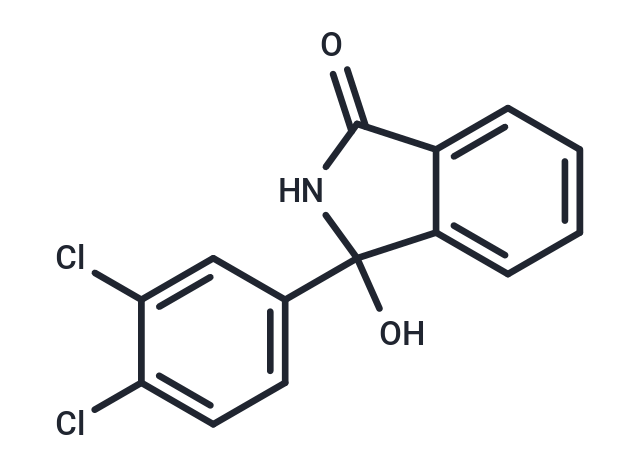 Your shopping cart is currently empty
Your shopping cart is currently empty

Chlorthalidone impurity G is a potential impurity found in commercial preparations of chlorthalidone that has moderate antihypertensive effects. Chlorthalidone is a thiazide-like diuretic that inhibits the Na+/Cl- cotransporter in the distal convoluted tubule of the kidney, which prevents reabsorption of sodium and chloride leading to a reduction in plasma volume and cardiac output. It also inhibits carbonic anhydrase (CA), including the isoforms CAVB, VII, IX, XII, and XIII (Kis = 2.8-23 nM) and, to a lesser extent, CAI, CAII, IV, VA, and VI (Kis = 138-1,347 nM), which may mediate its sustained vasodilatory activity. Dietary administration of chlorthalidone (8 mg per animal per day) reduces arterial hypertension and prevents or reduces ventricular hypertrophy induced by deoxycorticosterone acetate (DOCA) in salt-hypertensive rats. Formulations containing chlorthalidone have been used alone or in combination with other antihypertensive agents to lower arterial blood pressure and as adjuvants to address edema caused by cardiac or renal disorders.

| Pack Size | Price | USA Warehouse | Global Warehouse | Quantity |
|---|---|---|---|---|
| 1 mg | Inquiry | 35 days | 35 days | |
| 5 mg | $489 | 35 days | 35 days |
| Description | Chlorthalidone impurity G is a potential impurity found in commercial preparations of chlorthalidone that has moderate antihypertensive effects. Chlorthalidone is a thiazide-like diuretic that inhibits the Na+/Cl- cotransporter in the distal convoluted tubule of the kidney, which prevents reabsorption of sodium and chloride leading to a reduction in plasma volume and cardiac output. It also inhibits carbonic anhydrase (CA), including the isoforms CAVB, VII, IX, XII, and XIII (Kis = 2.8-23 nM) and, to a lesser extent, CAI, CAII, IV, VA, and VI (Kis = 138-1,347 nM), which may mediate its sustained vasodilatory activity. Dietary administration of chlorthalidone (8 mg per animal per day) reduces arterial hypertension and prevents or reduces ventricular hypertrophy induced by deoxycorticosterone acetate (DOCA) in salt-hypertensive rats. Formulations containing chlorthalidone have been used alone or in combination with other antihypertensive agents to lower arterial blood pressure and as adjuvants to address edema caused by cardiac or renal disorders. |
| Molecular Weight | 294.13 |
| Formula | C14H9Cl2NO2 |
| Cas No. | 16289-13-7 |
| Smiles | OC1(NC(=O)c2ccccc12)c1ccc(Cl)c(Cl)c1 |
| Relative Density. | no data available |
| Storage | Powder: -20°C for 3 years | In solvent: -80°C for 1 year | Shipping with blue ice/Shipping at ambient temperature. | |||||||||||||||||||||||||||||||||||
| Solubility Information | Ethanol: 10 mg/mL (34 mM), Sonication is recommended. DMF: 30 mg/mL (102 mM), Sonication is recommended. DMSO:PBS (pH 7.2) (1:1): 0.5 mg/mL (1.7 mM), Sonication is recommended. DMSO: 30 mg/mL (102 mM), Sonication is recommended. | |||||||||||||||||||||||||||||||||||
Solution Preparation Table | ||||||||||||||||||||||||||||||||||||
Ethanol/DMF/DMSO
DMF/DMSO
| ||||||||||||||||||||||||||||||||||||
| Size | Quantity | Unit Price | Amount | Operation |
|---|

Copyright © 2015-2026 TargetMol Chemicals Inc. All Rights Reserved.